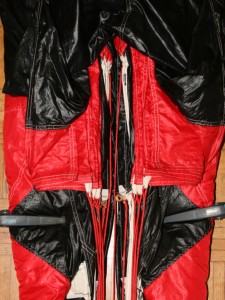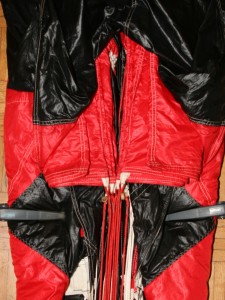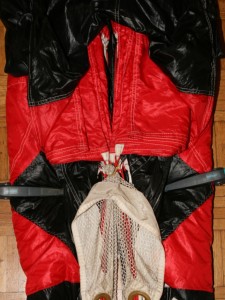A simple and effective way to make the direct slider control also work as tailgate for slider up jumps. This isn’t my idea and some of you maybe have seen this before or already use this.
If you don’t use direct control because you think the rubber bands may damage your slider you will not like this method…
1. Do a normal packjob, and seperate left and right line groups, have rubber bands for direct control on both C line attachment points.
2. Put the center D lines between the center C’s.

3. Put the brake lines between the center C’s. Watch out that no other C or D lines are between the center C’s (so only the tailgate lines are there).

4. Put the slider up, take a bit of the slider mesh and put the direct control on. (maybe take the first rubber band only once and the 2nd twice around the mesh, so that if one side is released the other one is too in the same moment)

Voilá, the slider locks the tailgate lines in the middle of the packjob as long as direct control is closed.
The advantages of this method:
- Its simple.
- If you are already using direct control, you don’t need to add or change anything on your setup.
- This should work as effective as a tailgate (since its pretty much the same).
- No additional hangup risk, actually this is less likely to hang up than a normal direct control. (I never heard of that happen anyways…)
- Except for a replacement rubber band every now and then you don’t need anything else to do a packjob.
The downside:
- Your consumption of tailgate rubber bands will increase. (They will break more often than with a normal direct control)
- The slider mesh will maybe wear out faster, since the tailgate lines are in direct contact with the slider mesh on every opening. I’m not jumping this setup for long enough to give any useful data on this, I can just add that I have used normal direct control for about 250 jumps and my slider is still good. (anyways, making your big-hole-mesh-slider to a bigger-hole-mesh-slider isn’t as bad as they say 😉
- Not really useful for low slider up jumps where you wouldn’t use direct control in the first place.
- If you use a deep brake setting so that the brake line attachments are below the C-line attachments this doesn’t work. I found this is works on Trolls with a brake setting already a bit deeper than the factory setting, and should work with factory linesets on Troll DWs, Trangos, and Mojos.
A bit on alternative slider up tailgating mechanisms:
- Normal tailgate setup and big-hole-mesh-slider is a big no-no.
- Having masking tape somwehere in my packed rig for a longer period of time would make me worry on the exit, and, although unlikely, can hangup. (this really happened…)
- Rubberband attached to slider edge to put brake lines into shortens the brake lines a bit, it messes up the way I pack, and I could image this causing tension knots since the lines not touching rubber would be released earlier than the ones that do.
- Tailgate sewn to slider edge is also more hang up prone than this method.
- Larksheading a rubberband around tailgate lines and locking it with a piece of slider is a good idea, but will equally wear out your slider and you will loose the rubberband on every jump. Although this would be a good alternative if your brake setting doesn’t allow you to use this method.
Thats my 2 cents on slider up line control methods. Comments are welcome.
One more thing, I always said “just pack nice and you will never have a lineover“, I’m taking this back, sometimes the shit just hits the fan. This was a nice packjob: Lineover clearing itself
So I’m going with this method now.
I agree with the concepts here, I like using direct control and have been using a similar setup. I normally just wrap the brake lines with the slider mesh and leave the C lines out of it. Except of course where i have my little direct control band.